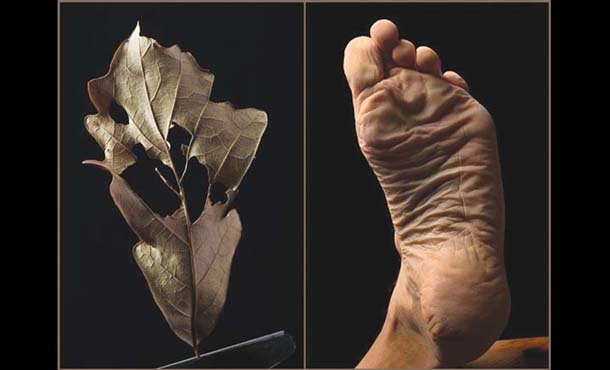Spitzer Art Center’s May featured gallery artist is photographer Howard Zehr who explores the beauty of aging through a series of portraits and fall foliage.
His photography exhibit titled “Autumn Leaves, Reflections of Aging” consists of three visual vignettes of aging, including pairings of Zehr’s body with autumn leaves, portraits of hands and a progression of portraits of a few of his friends at three points during their lives.
A series of portraits of Zehr’s wife at various points in her life also is included in the exhibit.
The goal of the project, according to Zehr, is to bring awareness to the beauty inherent in the aging process.
“I always said I was going to get T-shirts that said `Embrace Old-Fartdom,'” Zehr said. “Aging is a part of life, and there’s a beauty in it.”
Noting Zehr’s semi-retired status, one might draw the conclusion that the idea for the exhibit was sparked by Zehr qualifying for social security – and they would be correct.
“I have become increasingly aware of the process of aging and decided to embrace this process and treat the changes in my body with curiosity and respect, as a natural part of the cycle of life and death,” he said. “I have found myself identifying with these leaves and am exploring parallels between these leaves and my body.”
Zehr, the co-director of the Zehr Institute for Restorative Justice at Eastern Mennonite University, said his fascination with autumn leaves began several years ago, when he considered that each leaf is highly individual, displaying the scars of their varied lives.
“I felt captured by the beauty in the leaves that, in many people’s eyes, are past their prime,” he said. “Then I realized you could say the same thing about the human body.”
Zehr, whose love for photography began when he was forced to create his own microfilm while studying in Germany and France without a photocopier, has always enjoyed taking photographic portraits, saying he is especially drawn to the textures and individualities shown in close-up portraits.
For example, in his “Doing Life” photography series, Zehr combined his love of close-up portraits with his restorative justice work to feature inmates at a Philadelphia prison who were serving a life sentence.
“We usually think about prisoners and so-called offenders as real stereotypes,” he said. “I wanted us to confront them as real people, and the way to do that is bringing you up close.”
Zehr said he wanted to photograph the leaves for his “Reflections of Aging” the same way he would photograph portraits, with a focus on the story and beauty of each individual leaf.
Originally, the leaf portraits were meant to be shown on their own until Zehr began working on exercises in a book on portrait photography. He had to take close-ups of his own body and began finding similarities between the leaves and his self-portraits.
“I had done these two things separately before I started to realize that I could find connections,” he said. “Part of the fun then became going through my collection of leaves and body and finding ones that connected.”
The vignette featuring the age progression of Zehr’s friends was a project that took decades to come to fruition.
When Zehr was in his 40s, he asked some friends to show him a photograph of when they were about 12 years old. Zehr then copied the photos and did a contemporary portrait of each friend in the same attitude as the childhood photo.
“I went back a few years ago – while they were in their 60s or later – and photographed them again,” Zehr said. “It’s really interesting to see the people and things that are different yet similar; the mouths and the eyes are all similar.”
By looking at the different vignettes of aging, Zehr hopes people of all ages take something away from the exhibition.
“A lot of people look at aging pretty negatively,” he said. “So, I hope for older people it’s an affirmation, and I hope it helps younger people to think more positively about the aging process.”
Zehr notes that Nancy Ross Hugo, in her book “Seeing Trees,” says that a person can learn from the imperfection of leaves. Hugo sites a quote from artist and writer Richard Bell that can apply to leaves as well as flowers: “Perfect blooms can leave me cold: I like a plant with a story.”
An opening reception was held May 1 and additional viewings will be Saturdays in May from 10 a.m. to 2 p.m.
For more information, visit spitzerartcenter.org or call 540-433-2199.
Article courtesy of the Daily News Record, May 7, 2015
